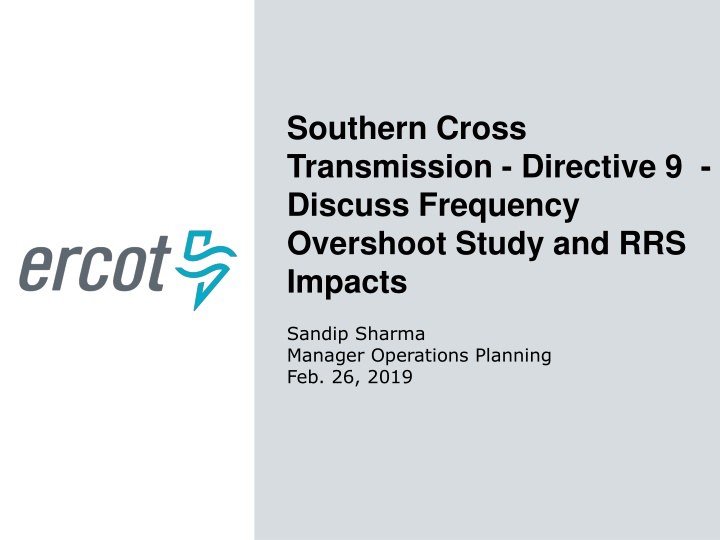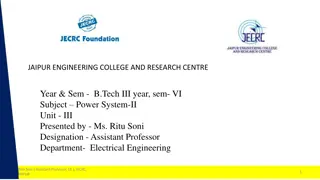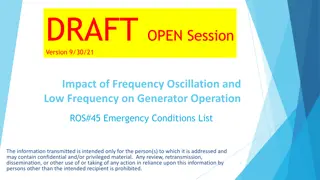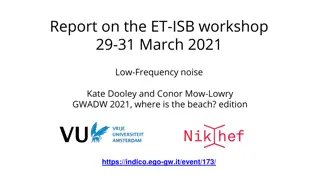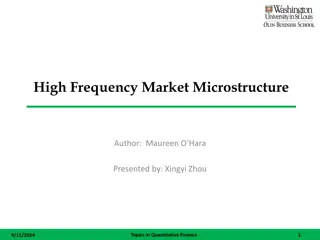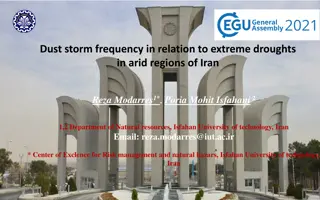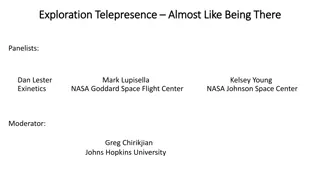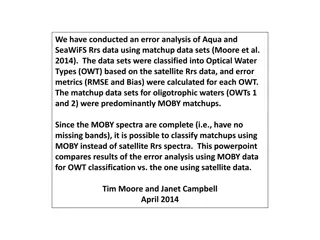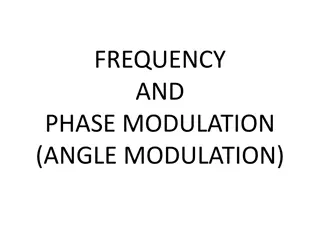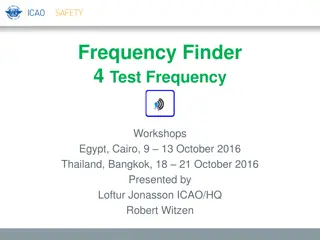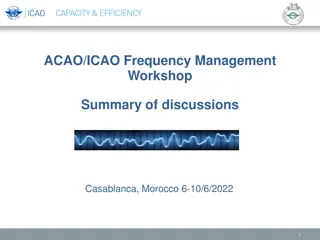Frequency Overshoot Study & RRS Impacts Exploration
In-depth analysis of the Frequency Overshoot Study concerning the impact of SCT DC Tie trips on the ERCOT grid's frequency, along with insights on the Responsive Reserve Service (RRS) impacts. This study delves into various scenarios, frequency responses, limits imposed on DC Tie exports, and the methodology behind the RRS per ERCOT's current AS.
Download Presentation

Please find below an Image/Link to download the presentation.
The content on the website is provided AS IS for your information and personal use only. It may not be sold, licensed, or shared on other websites without obtaining consent from the author.If you encounter any issues during the download, it is possible that the publisher has removed the file from their server.
You are allowed to download the files provided on this website for personal or commercial use, subject to the condition that they are used lawfully. All files are the property of their respective owners.
The content on the website is provided AS IS for your information and personal use only. It may not be sold, licensed, or shared on other websites without obtaining consent from the author.
E N D
Presentation Transcript
Southern Cross Transmission - Directive 9 - Discuss Frequency Overshoot Study and RRS Impacts Sandip Sharma Manager Operations Planning Feb. 26, 2019
Frequency Overshoot Study Impact of SCT DC Tie trips when exporting Sudden instantaneous trip of SCT DC Tie when exporting power could cause ERCOT grid frequency to overshoot. If the resulting frequency overshoot is too high, the high overshoot values could trigger other Generation Resources to trip on over-frequency protection. Assumptions and Methodology All governors of on-line synchronous Generation Resources will be enabled to provide frequency response All on-line wind farms with PFR capability will be modeled to provide downward response to over frequency Trip SCT DC Tie while exporting 2,100 MW. The sensitivity study with load damping factor assumed to be 0% and 2% will be conducted for each case. Record frequency trend and identify any frequency overshoot that exceeds 60.6 Hz. In the cases where frequency overshoot exceeds 60.6 Hz, additional sensitivity studies will be conducted to identify an export limit on the SCT DC Tie such that frequency overshoot will not exceed 60.6 Hz. PUBLIC 2
Scenarios Used for Frequency Overshoot Study INERTIA (GW S) 130 LOAD (GW) 34 WIND (GW) 15.5 SYNCHRONOUS GEN (GW) 19 SCENARIO NAME SCENARIO 0 SCENARIO 1 130 34 10 24.5 SCENARIO 2 130 32 5 27.5 SCENARIO 3 130 32 3.5 29 SCENARIO 4 120 29.9 3.5 26.9 SCENARIO 5 110 27.2 3.5 24.2 PUBLIC 3
Frequency Response when Tripping SC DC Tie Export at 2,100 MW Scenario 0 Scenario 1 Scenario 2 Scenario 3 Scenario 4 Scenario 5 Highest Frequency Overshoot (Hz) DR=2.0 60.38 60.47 60.51 60.53 60.60 60.70 Highest Frequency Overshoot (Hz) DR=0.0 60.42 60.54 60.60 60.62 60.73 60.89 PUBLIC 4
Limit Imposed on SC DC Tie Export Scenario 3 (130 GW s) Scenario 4 (120 GW s) Scenario 5 (110 GW s) Limit on SC DC tie export 2,000 MW 1,745 MW 1,488 MW PUBLIC 5
Responsive Reserve Service (RRS) Per ERCOT s current AS Methodology, minimum quantities of RRS are established based on historic (last two years) system inertia conditions and RRS studies (most recently conducted in 2017). RRS Studies are set up to determine at what amount of RRS a Generation Resource trip equal to ERCOT s Resource Contingency Criteria (RCC) as established by BAL-003, Under Frequency Load Shed (UFLS) would not be triggered. Scenario 1 - SCT DC Tie import is limited to existing ERCOT Most Severe Single Contingency (MSSC) at 1,375 MW Scenario 2 - SCT DC Tie import is above existing ERCOT MSSC up to 2,000 MW PUBLIC 6
Scenario 2: RRS Case Study LR (MW) LR/PFR Ratio PFR (No LR) (MW) Case No. INERTIA (GW s) PFR (MW) Time w/o SCDCT w/ SCDCT w/o SCDCT w/ SCDCT w/o SCDCT w/ SCDCT 10-Feb-17 01:00:00 130 1150 1900 2650 2.39 2.94 5691 8941 *Case1 31-Mar-14 02:00:00 140 1150 1800 3250 2.17 3.29 5056 11843 Case2 21-Mar-14 02:00:00 150 1150 1750 2900 1.85 2.59 4388 8661 Case3 23-Oct-16 00:00:00 160 1150 1700 2550 1.85 2.43 4295 7347 Case4 28-Oct-13 00:00:00 180 1150 1650 2375 1.71 1.98 3972 5853 Case5 24-Nov-16 15:00:00 200 1150 1450 2100 1.43 1.53 3224 4363 Case6 02-Apr-14 10:00:00 220 1150 1500 2150 1.55 1.68 3475 4762 Case7 05-Oct-13 18:00:00 260 1150 1450 2150 1.10 1.17 2745 3666 Case8 28-May-14 18:00:00 290 1150 1300 1950 1.00 1.06 2450 3217 Case9 03-Sep-13 18:00:00 359 1150 1150 1800 1.00 1.12 2300 3166 Case10 07-Aug-13 17:00:00 376 1150 1050 1700 1.00 0.95 2085 2765 Case11 *Case 1 : With RCC increased to 3,375 MW, ERCOT s critical inertia goes up to around 130 GW*s. As a result, current RRS mix is insufficient to arrest system frequency above 59.4 Hz. Therefore, for the case with 130 GW*s inertia, LRs response time are shortened to 15 cycles to improve frequency nadir. PUBLIC 7
Interpolated PFR (No LR) Quantities *Note: With RCC increased to 3,375 MW, ERCOT s critical inertia becomes 130 GW s. As a result, current RRS mix is insufficient to arrest system frequency above 59.4 Hz. Therefore, for the case with 130 GW s inertia, LRs response time are shortened to 15 cycles to improve frequency nadir. PFR quantity related to 130 GW s is not included for interpolation. PUBLIC 8
Interpolated LR/PFR Equivalency Ratio *Note: With RCC increased to 3,375 MW, ERCOT s critical inertia becomes 130 GW s. As a result, current RRS mix is insufficient to arrest system frequency above 59.4 Hz. Therefore, for the case with 130 GW s inertia, LRs response time are shortened to 15 cycles to improve frequency nadir. PFR quantity related to 130 GW s is not included for interpolation. PUBLIC 9
Interpolated RRS Quantities *Note: With RCC increased to 3,375 MW, ERCOT s critical inertia becomes 130 GW s. As a result, current RRS mix is insufficient to arrest system frequency above 59.4 Hz. Therefore, for the case with 130 GW s inertia, LRs response time are shortened to 15 cycles to improve frequency nadir. PFR quantity related to 130 GW s is not included for interpolation. PUBLIC 1 0
RRS Quantity Increase HE 1 2 3 4 5 6 7 8 9 10 11 12 13 14 15 16 17 18 19 20 21 22 23 24 Jan Feb Mar Apr May Jun Jul Aug Sep Oct Nov Dec 1158 1158 1158 1158 613 392 376 385 407 776 1158 776 1158 1158 1158 1158 613 392 376 385 407 776 1158 776 1158 1158 1158 1386 776 394 385 383 429 776 1158 776 1158 1158 1158 1386 776 394 385 383 429 776 1158 776 1158 1158 1158 1386 776 394 385 383 429 776 1158 776 1158 1158 1158 1386 776 394 385 383 429 776 1158 776 776 613 776 969 435 383 376 376 394 435 776 435 776 613 776 969 435 383 376 376 394 435 776 435 776 613 776 969 435 383 376 376 394 435 776 435 776 613 776 969 435 383 376 376 394 435 776 435 613 435 613 613 394 384 391 391 376 407 613 429 613 435 613 613 394 384 391 391 376 407 613 429 613 435 613 613 394 384 391 391 376 407 613 429 613 435 613 613 394 384 391 391 376 407 613 429 613 435 613 613 392 388 336 370 379 407 613 407 613 435 613 613 392 388 336 370 379 407 613 407 613 435 613 613 392 388 336 370 379 407 613 407 613 435 613 613 392 388 336 370 379 407 613 407 776 613 613 613 392 379 391 391 376 407 613 429 776 613 613 613 392 379 391 391 376 407 613 429 776 613 613 613 392 379 391 391 376 407 613 429 776 613 613 613 392 379 391 391 376 407 613 429 1158 1158 1158 1158 613 392 376 385 407 776 1158 776 1158 1158 1158 1158 613 392 376 385 407 776 1158 776 2019 Total RRS (w/o SCDCT) 2019 Total RRS (w/ SCDCT) Delta 23,716,368 MWh 28,986,904 MWh 5,270,536 MWh PUBLIC 1 1
Study Conclusions RRS Impact Scenario 1: The addition of the 2,000 MW SCT DC Tie import would increase ERCOT s Resource Contingency Criteria (RCC) from the current 2750 MW to 3375 MW, per BAL-0031 Standard. ERCOT studies show additional RRS would be needed to protect against the larger RCC. Using the 2019 expected system inertia, ERCOT studies show an additional 5,270,536 MWh of RRS would be required for 2019. Scenario 2: If SCT DC Tie imports are limited to the current ERCOT-defined MSSC (i.e. not considering the SCT DC Tie), then ERCOT s Resource Contingency Criteria (RCC) would not change and there would be no incremental RRS requirement. Frequency Overshoot Instantaneous trip of a 2100 MW SCT DC Tie export during certain low inertia hours could cause frequency overshoot. Without an export limit for low inertia conditions, a new ancillary service would be required to protect against possible frequency overshoot. During certain low inertia hours, an export limit for the SCT DC Tie would address the potential overshoot problem and would eliminate the need for new ancillary services. ERCOT studies of the modeled scenarios showed the export limit to be as low as 1,488 MW. This limit could be higher or lower under system conditions that differ from the ones studied. 1. The NERC BAL-003 Standard is currently under review. These conclusions may need to be revisited if the RCC changes. . PUBLIC 1 2
QUESTIONS? PUBLIC 1 3
